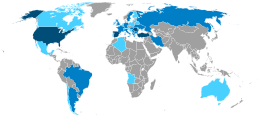Our website is made possible by displaying online advertisements to our visitors.
Please consider supporting us by disabling your ad blocker.
Roma people
 Romani flag created in 1933 and accepted at the 1971 World Romani Congress | |
 | |
| Total population | |
|---|---|
| 2–20 million | |
| Regions with significant populations | |
| 2,750,000 | |
| 1,850,000 | |
| 750,000[1] | |
| 725,000[2] | |
| 720,000 | |
| 700,000[3] | |
| 500,000[4] | |
| 400,000[5] | |
| 265,000[6] | |
| 250,000[7] | |
| 140,000[8] | |
| 105,000[9] | |
| Languages | |
| Romani, languages of native regions | |
| Religion | |
| mainly Christianity and Islam, minorities practice Buddhism, Judaism and Bahá'í Faith | |









The Roma, or Romani people, are an Indo-Aryan ethnic group. The Roma originated from India, but they migrated westward around 500 AD and arrived in Europe around 1000 AD.[10]
- ↑ "Bulgaria". commission.europa.eu.
- ↑ "Spain". commission.europa.eu.
- ↑ "Hungary". commission.europa.eu.
- ↑ "Slovakia". commission.europa.eu.
- ↑ "France". commission.europa.eu.
- ↑ "Greece". commission.europa.eu.
- ↑ "Czech Republic". commission.europa.eu.
- ↑ "Italy". commission.europa.eu.
- ↑ "Germany". commission.europa.eu.
- ↑ "The Lost Tribes of India". 2 June 2004.
Previous Page Next Page


